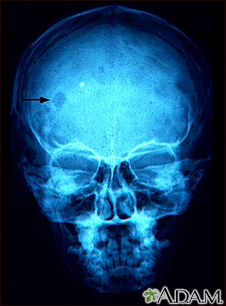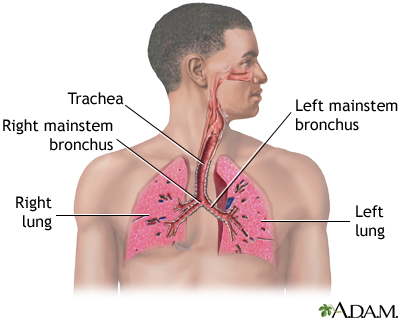Histiocytosis
Langerhans cell histiocytosis; Erdheim-Chester disease
Histiocytosis is a general name for a group of disorders or "syndromes" that involve an abnormal increase in the number of specialized white blood cells that are called histiocytes.
Recently, new knowledge about this family of diseases has led experts to develop a new classification. Five categories have been proposed:
- L group -- includes Langerhans cell histiocytosis and Erdheim-Chester disease
- C group -- includes non-Langerhans cell histiocytosis that involves the skin
- M group -- includes malignant histiocytosis
- R group -- includes Rosai-Dorfman disease
- H Group -- includes hemophagocytic lymphohistiocytosis
This article focuses only on the L group, which includes Langerhans cell histiocytosis and Erdheim-Chester disease.
Images


Causes
There has been debate as to whether Langerhans cell histiocytosis and Erdheim-Chester disease are inflammatory, immune disorders, or cancer-like conditions. Recently, through the use of genomics scientists have found that these forms of histiocytosis show gene changes (mutations) in early white blood cells. This leads to abnormal behavior in the cells. The abnormal cells then increase in various parts of body including the bones, skin, lungs, and other areas.
Langerhans cell histiocytosis is a rare disorder that can affect people of all ages. The highest rate is among children ages 5 to 10. Some forms of the disorder are genetic, which means they are inherited.
Erdheim-Chester disease is a rare form of histiocytosis affecting mainly adults that involves multiple parts of the body.
Symptoms
Both Langerhans cell histiocytosis and Erdheim-Chester disease can affect the whole body (systemic disorder).
Symptoms can vary between children and adults, but they may have some of the same symptoms. Tumors in weight-bearing bones, such as the legs or spine, may cause the bones to fracture without an obvious reason.
Symptoms in children may include:
- Abdominal pain
- Bone pain
- Delayed puberty
- Dizziness
- Ear drainage that continues long-term
- Eyes that appear to stick out more and more
- Irritability
- Failure to thrive
- Fever
- Frequent urination
- Headache
- Jaundice
- Limping
- Mental decline
- Rash
- Seborrheic dermatitis of the scalp
- Seizures
- Short stature
- Swollen lymph glands
- Thirst and increased drinking of fluids
- Vomiting
- Weight loss
Note: Children over 5 years old often have only bone involvement.
Symptoms in adults may include:
- Bone pain
- Chest pain
- Cough
- Fever
- General discomfort, uneasiness, or ill feeling
- Increased amount of urine
- Rash
- Shortness of breath
- Thirst and increased drinking of fluids
- Weight loss
Exams and Tests
There are no specific blood tests for Langerhans cell histiocytosis or Erdheim-Chester disease. The tumors produce a "punched-out" look on a bone x-ray. Specific tests vary, depending on the age of the person.
Tests for children may include:
- Biopsy of skin to check for Langerhans cells
- Bone marrow biopsy to check for Langerhans cells
- Complete blood count (CBC)
- X-rays of all the bones in the body to find out how many bones are affected
- Test for a gene mutation in BRAF called V600E
Tests for adults may also include:
- Biopsy of any tumor or mass
- Imaging of the body, including x-ray, CT scan, MRI, or PET scan
- Bronchoscopy with biopsy
- Pulmonary function tests
- Blood and tissue testing for gene mutations including BRAF V600E. This testing may need to be done at a specialized center.
Langerhans cell histiocytosis is sometimes linked to cancer. CT scans and biopsy should be done to check for possible cancer.
Treatment
People with Langerhans cell histiocytosis that involves only a single area (such as bone or skin) may be treated with local surgery. However, they will need to be followed closely to look for signs that the disease has spread.
People with widespread Langerhans cell histiocytosis or Erdheim-Chester disease require medicines to reduce symptoms and control the spread of the disease. Recent studies show that nearly all adults with widespread histiocytosis have gene mutations in the tumors, which appear to cause the disorder. Medicines that inhibit these gene mutations, such as vemurafenib are currently available. Other similar medicines are also in development.
Langerhans cell histiocytosis and Erdheim-Chester disease are very rare disorders. Therefore there is limited information about the best course of treatment. People with these conditions may want to take part in ongoing clinical trials designed to identify new treatments.
Other medicines or treatments may be used, depending on the outlook (prognosis) and response to the starting medicines. Such treatments may include:
- Interferon alpha
- Cyclophosphamide or vinblastine
- Etoposide
- Methotrexate
- Vemurafenib, if the BRAF V600E mutation is found
- Stem cell transplantation
Other treatments may include:
- Antibiotics to fight infections
- Breathing support (with a breathing machine)
- Hormone replacement therapy
- Physical therapy
- Special shampoos for scalp problems
- Supportive care (also called comfort care) to relieve symptoms
In addition, people with these conditions who smoke are encouraged to stop since smoking may worsen the response to treatment.
Support Groups
More information and support for people with histiocytosis and their families can be found at:
Histiocytosis Association -- histio.org
Outlook (Prognosis)
Langerhans cell histiocytosis and Erdheim-Chester disease can affect many organs and can lead to death.
About one half of those with pulmonary histiocytosis improve, while others have permanent loss of lung function over time.
In very young people, the outlook depends on the specific histiocytosis and how severe it is. Some children can live a normal life with minimal disease involvement, while others do poorly. Young children, especially infants, are more likely to have body-wide symptoms that lead to death.
Possible Complications
Complications may include:
- Diffuse interstitial pulmonary fibrosis (deep lung tissues that become inflamed and then damaged)
- Spontaneous collapsed lung
Children may also develop:
- Anemia caused by spreading of the tumors to the bone marrow
- Diabetes insipidus
- Lung problems that lead to lung failure
- Problems with the pituitary gland that lead to growth failure
When to Contact a Medical Professional
Contact your health care provider if you or your child has symptoms of this disorder. Go to the emergency room if shortness of breath or chest pain develops.
Prevention
Avoid smoking. Quitting smoking can improve the outcome in people with Langerhans cell histiocytosis that affects the lungs.
There is no known prevention of this disease.
Related Information
MacrophageBone x-ray
Anemia
Interstitial lung disease
Diabetes insipidus
References
Goyal G, Young JR, Koster MJ, et al. The Mayo Clinic Histiocytosis Working Group consensus statement for the diagnosis and evaluation of adult patients with histiocytic neoplasms: Erdheim-Chester disease, Langerhans cell histiocytosis, and Rosai-Dorfman disease. Mayo Clin Proc. 2019;94(10):2054-2071. PMID: 31472931 pubmed.ncbi.nlm.nih.gov/31472931/.
Rollins BJ, Berliner N. Histiocytoses. In: Goldman L, Cooney KA, eds. Goldman-Cecil Medicine. 27th ed. Philadelphia, PA: Elsevier; 2024:chap 155.
BACK TO TOPReview Date: 5/9/2024
Reviewed By: Neil J. Gonter, MD, Assistant Professor of Medicine, Columbia University, NY and private practice specializing in Rheumatology at Rheumatology Associates of North Jersey, Teaneck, NJ. Review provided by VeriMed Healthcare Network. Also reviewed by David C. Dugdale, MD, Medical Director, Brenda Conaway, Editorial Director, and the A.D.A.M. Editorial team.

Health Content Provider
06/01/2025
|
A.D.A.M., Inc. is accredited by URAC, for Health Content Provider (www.urac.org). URAC's accreditation program is an independent audit to verify that A.D.A.M. follows rigorous standards of quality and accountability. A.D.A.M. is among the first to achieve this important distinction for online health information and services. Learn more about A.D.A.M.'s editorial policy, editorial process and privacy policy. A.D.A.M. is also a founding member of Hi-Ethics. This site complied with the HONcode standard for trustworthy health information from 1995 to 2022, after which HON (Health On the Net, a not-for-profit organization that promoted transparent and reliable health information online) was discontinued. |
The information provided herein should not be used during any medical emergency or for the diagnosis or treatment of any medical condition. A licensed medical professional should be consulted for diagnosis and treatment of any and all medical conditions. Links to other sites are provided for information only -- they do not constitute endorsements of those other sites. © 1997- 2025 A.D.A.M., a business unit of Ebix, Inc. Any duplication or distribution of the information contained herein is strictly prohibited.
